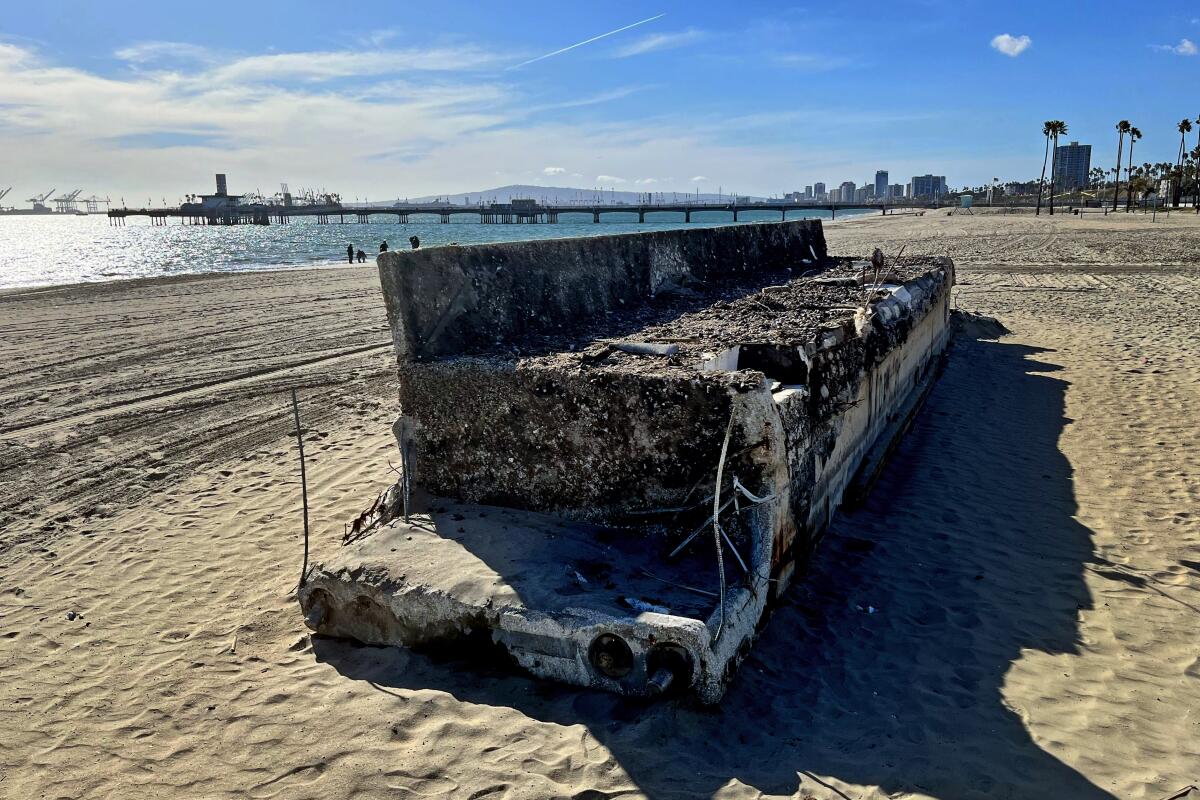A bus-sized piece of concrete on the beach: A tale of waste, neglect and climate change

- Share via
Long Beach residents are accustomed to seeing debris on their beaches in the aftermath of inclement weather. So Annette Freuhan wasn’t the least bit fazed when she woke up the day after the torrential rains in early February to see a concrete slab the size of a bus washed ashore on Junipero Beach.
“The ocean is pretty powerful,” said the 80-year-old homeowner. As Freuhan spoke, she could see a bulldozer clearing up smaller debris on the beach surrounding the concrete block. “I don’t see it as being unusual because we have had whole huge trees that sometimes wash up.”
Tree trunks, littered beer bottles, even the wreckage of a sunken ship — Freuhan has seen it all over the last seven years in her home overlooking Bluff Park.
But this particular concrete slab sparked several questions. What is it? Where did it come from? How did it make it to the beach? And how, exactly, would the city get rid of the thing?
To answer the third question first, apparently concrete can float. (The American Society of Civil Engineers hosts an annual concrete canoe competition.) According to Archimedes’ principle, a buoyant object just needs to displace more water than it weighs. And concrete is a pretty common material used in the boating business.
As for the first question, Todd Leland, the marine manager of Long Beach’s Department of Parks, Recreation and Marine, said the hulking slab “is a dock structure, it’s made of concrete and Styrofoam plastic products.” Leland believes a weakness in that particular dock was exposed during last month’s storms, and the flood of water from the L.A. River flowing into the marina only made things worse.
“We believe [the concrete] is from a private marina in a state of disrepair... [But] with any debris that ended up on our beachfront, we can’t be 100% sure,” he said.
The likely suspect is the Harbor Light Marina adjacent to the nearby Hotel Maya. When contacted, the hotel responded that it leases the marina from the city, and the Harbor Island Yacht Club subleases it from the hotel.
“Harbor Light Marina had a contractual responsibility for management and maintenance for the marina,” the Hotel Maya said in a statement by email. The hotel added that the yacht club “recently decided not to renew its sublease for the marina.”
The yacht club declined to comment, but on its website it stated that it has “not been able to negotiate a lease extension with the Hotel Maya and the hotel has decided to close the marina.” Without a space to accommodate their vessels, they are “in the process of moving the fleet back to San Diego.”
Setting aside the question of who was responsible for the lack of maintenance, there’s still the matter of disposing of this concrete. Leland estimates the block weighs somewhere between one to two tons; city workers have been inching the block across the sand.
“We’ve taken the last couple of weeks to slowly move the concrete about two miles from the west beach to our east beach maintenance location for a contained demolition and haul-off,” said Leland. The demolition might take days because they have to be careful not to pollute as they break down the concrete and Styrofoam.
Leland said they’re prepared to deal with all sizes of waste; because of the way the tides flow, Long Beach is on the receiving end of the water and trash that run down the L.A. River. In its budget for 2024, the city reported removing 3,500 metric tons of waste in river debris during 2023, 42% more than the year prior. So far this year, the city has already collected 1,600 metric tons from the storms that hit Southern California. The city estimates that it spends $1 million a year disposing this waste.
It’s costly and time-intensive to deal with the pollution washing up on the beach, not to mention disruptive to local ecosystems.
Richard Ambrose, a professor of environmental health sciences at UCLA, said there are animals such as beach hoppers, sand crabs and worms living in the sand that can get crushed by large pieces of debris or even the vehicles removing waste.
“In general, from the ecological point of view, it’s better not to be driving on the beach or bringing heavy equipment down,” Ambrose said. But leaving the waste on the beach isn’t really an option, either; it’s also bad if animals ingest plastics and other waste.
Climate change could also increase the taxpayer costs associated with managing marinas and coastal regions, according to Ambrose. “We need to plan for having more extreme events like we’ve just had and to make sure that the infrastructure is ready,” he said. That’s just in the short term; in the long term there may be other concerns as well. “As the sea level gets higher and higher, there’s infrastructure that hasn’t been exposed to big waves in the past or flooding.”







